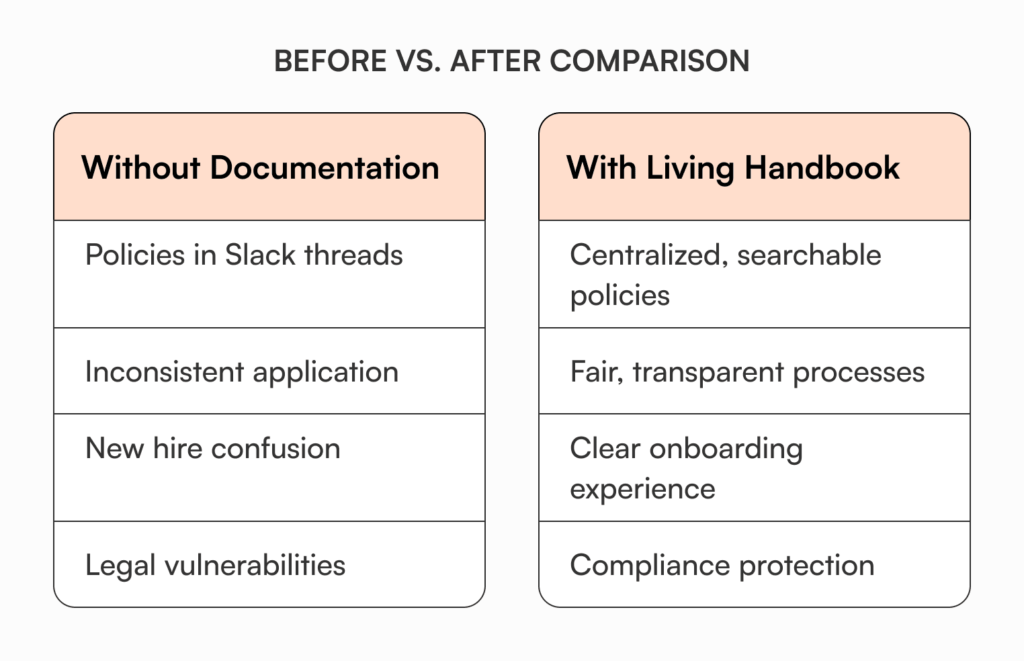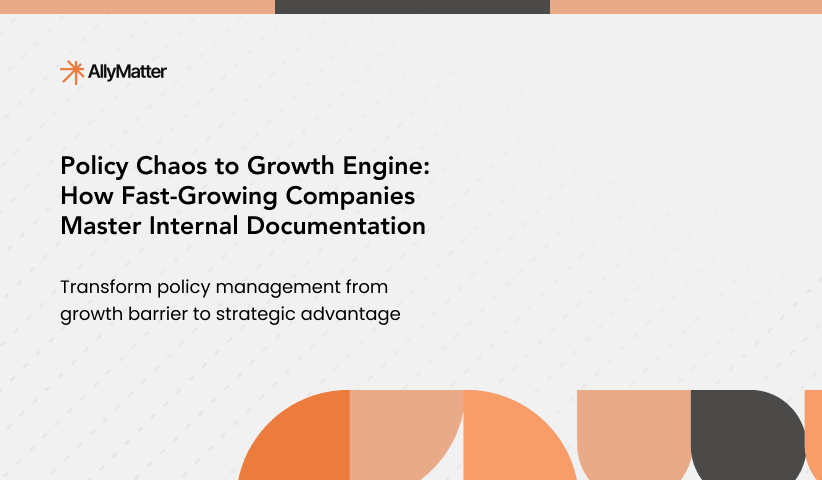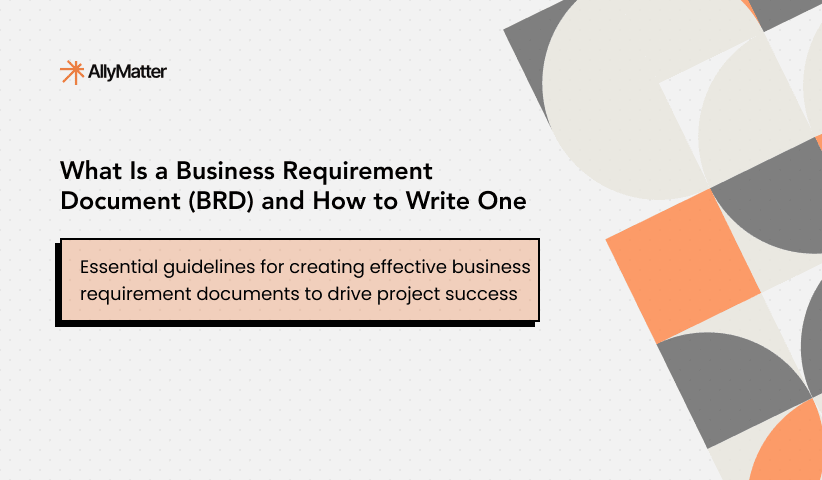The email came at 4:47 PM on a Friday.
“Hey, quick question – what’s our policy on remote work again? My partner just got a job offer in Austin and we’re thinking about relocating.”
Your stomach drops. You remember having this conversation about remote work… somewhere. Was it in Slack? During that all-hands meeting three months ago? You definitely told everyone the policy, but now, facing an employee’s life-changing decision, you realize: if it’s not written down, it might as well not exist.
This scenario plays out in startups every day. You’re moving fast, policies evolve organically, and everyone just “knows” how things work through some form of cultural osmosis. Until they don’t. Until someone new joins and gets conflicting information. Until someone misremembers a crucial detail. Until you need to prove to an auditor, lawyer, or investor that yes, you do have proper employment practices in place.
Your HR handbook isn’t just a nice-to-have corporate document. It’s the difference between scaling smoothly and drowning in confusion, miscommunication, and potentially expensive legal issues.
The hidden cost of “tribal knowledge” HR
Let’s talk about what really happens when HR policies live only in people’s heads and Slack threads:
The telephone game effect: Your vacation policy starts as “flexible time off” in your mind. It becomes “unlimited PTO” when you tell your co-founder, morphs into “take time whenever” when they explain it to a new hire, and suddenly someone’s planning a three-month sabbatical. Each person in the chain adds their own interpretation, and now you’re dealing with wildly different expectations.
The inequality problem: When policies aren’t documented, their application becomes inconsistent. Sarah gets to work from Bali for a month because she asked you after the company closed a big deal. Tom’s identical request gets denied because he asked during a stressful sprint. Now you have a fairness issue brewing, with employees comparing notes and wondering why some people get special treatment.
The new hire confusion: Every new employee goes through the same painful process of piecing together how things work. They spend their first month navigating scattered Slack messages and “I think the policy is…” conversations. Their onboarding becomes unnecessarily stressful, and they’re making decisions based on incomplete information.
Additionally, according to the Society for Human Resource Management, it takes new hires 8-12 months to achieve full productivity in professional roles – often because they’re navigating unclear policies and scattered information instead of focusing on their actual work.”
The legal time bomb: Employment law doesn’t care that you verbally told everyone about your anti-harassment policy. If it’s not documented, distributed, and acknowledged, you might as well have no policy at all when issues arise. Even the best teams can have conflicts, and when they do, your informal approach won’t protect anyone.

Why early-stage startups resist HR documentation
I get it. You’re not trying to build a bureaucracy. The resistance usually sounds like:
“We’re too small for formal policies” “Documentation will slow us down” “We trust our team” “HR handbooks are for corporate drones”
Here’s the reality check: You already have HR policies. Every time you approve a vacation request or explain your equity vesting schedule, you’re creating a policy. The only question is whether these policies are clear, consistent, and accessible to everyone who needs them.
The fear is that documentation equals bureaucracy, but it doesn’t have to. Good documentation actually enables the flexibility and speed startups need by creating clarity around decision-making.
The five HR documents that will save your startup
You don’t need a 200-page employee manual. Start with these five living documents that cover 90% of what matters:
1. The compensation & benefits one-pager
What goes here:
- How salary decisions are made (even if it’s simply “market rate based on experience”)
- Your equity philosophy and vesting schedule in plain English
- Health benefits and enrollment process
- Any perks (team lunches, learning budgets, equipment stipends)
Why it matters: Money conversations are awkward enough without ambiguity. When candidates ask about compensation philosophy or employees wonder about raises, you have a clear reference point. This document alone prevents countless uncomfortable conversations and ensures everyone understands the deal they’re signing up for.
2. The time & attendance reality check
Document the actual answers to:
- What are your core hours (if any)?
- How does remote work actually work?
- What’s the real vacation policy? (If it’s “unlimited,” what does that mean in practice?)
- How do sick days work?
- What happens on public holidays?
Skip the corporate speak. If your real policy is “get your work done and we’re flexible,” write that – just be specific about what flexibility means. Include examples: “Yes, you can leave early for your kid’s recital. No, you can’t disappear for two weeks without notice.”
3. The code of conduct that actually gets read
Instead of generic “be professional” statements, address real scenarios your team faces:
- Communication norms (Is it okay to Slack at midnight? What are expected response times?)
- What respectful disagreement looks like in your culture
- Your stance on side projects or freelancing
- Social media guidelines that reflect reality
- The actual process for reporting problems
Make it conversational and specific to your startup. If you wouldn’t say it out loud at an all-hands, it doesn’t belong in your code of conduct.
4. The performance & growth framework
Even if you’re too small for formal reviews, document:
- How and when performance conversations happen
- What good performance looks like in your specific startup context
- How promotions or role changes work
- The process for addressing performance issues
This prevents the dreaded “I had no idea there was a problem” conversation. It also helps high performers understand how to grow within your company, reducing the risk they’ll look elsewhere for advancement.
5. The onboarding & offboarding checklist
Your future self will thank you for writing down:
- First day/week expectations and logistics
- Who’s responsible for what in onboarding
- Standard equipment and access provisions
- The respectful exit process (yes, people will leave)
- What happens to equity when someone leaves
This document alone will save hours of scrambling every time someone joins or leaves. It also ensures consistent experiences that reflect well on your company culture.
Related reading: Internal Knowledge Base – HR Department Use Cases
Making your HR handbook actually live
Here’s where most startups fail: they create these documents once, stick them in a Google Drive folder, and forget they exist. Your handbook needs to evolve with your company.
Start with reality, not aspiration: Document what you actually do, not what you think you should do. If everyone works from home on Fridays, don’t write a “five days in office” policy. You can always update policies as you grow, but starting with fiction helps no one.
Date everything: Add “Last updated: [date]” to every document. When policies change, don’t delete the old version – mark it as outdated and explain what changed. This creates a paper trail that can save you during disputes or legal issues.
The monthly reality check: Set a recurring calendar reminder to review one section of your handbook each month. Takes 30 minutes, prevents major drift between policy and practice. During these reviews, ask: “Is this still how we actually do things?”
Make it discoverable: If people can’t find it, it doesn’t exist. Put your handbook where people actually look – whether that’s Notion, Slack pins, or your internal wiki. Consider creating a simple onboarding checklist that includes “Read and acknowledge HR handbook.”
The legal stuff you actually need to worry about
I’m not a lawyer (and this isn’t legal advice), but here are the areas where documentation isn’t optional:
Anti-harassment and discrimination
You need a written policy, a clear reporting process, and proof that employees have read it. This isn’t bureaucracy – it’s basic protection for your team and company. Without it, you’re one incident away from a costly lawsuit.
Wage and hour policies
Document how overtime works (or doesn’t), how you track time, and when people get paid. The Department of Labor doesn’t care that “everyone just knows” payday is every other Friday. Misclassification of employees or unclear overtime policies can result in significant penalties.
Leave policies
Medical leave, parental leave, jury duty – these often have legal requirements that vary by state. Document what you offer and how it works. Being generous is great, but being clear about that generosity is essential.
Safety and security
Even if you’re fully remote, document your security policies, data handling procedures, and emergency contacts. This becomes critical if you ever have a data breach or security incident.
Equity and compensation
The tax implications of getting equity documentation wrong can be catastrophic. Write down your equity policies and stick to them religiously. Include vesting schedules, exercise windows, and what happens in various exit scenarios.
From chaos to clarity: Making it happen
Here’s your game plan for the next two weeks:
Week 1: Document reality
- Block 2 hours to write down your actual current policies.
- Focus on the five essential documents above.
- Write in plain English, not HR-speak.
- Share drafts with your co-founders for gut-checks.
Week 2: Make it official
- Clean up the drafts based on feedback.
- Decide where these will live permanently.
- Share with your team in an all-hands or team meeting.
- Create a simple acknowledgment process.
Ongoing: Keep it living
- Add to your handbook when new situations arise.
- Update docs when policies change.
- Review quarterly as you grow.
- Get new hires to read and acknowledge during onboarding.

Related reading: Everything You Need to Know About Building a Knowledge Base for HR
When simple documents aren’t enough
As you grow beyond 20-30 employees, managing HR documentation gets complex. Multiple versions float around, no one knows what’s current, and tracking who’s acknowledged what becomes a nightmare. You’ll find yourself spending more time managing documents than managing people.
This is where tools like AllyMatter become invaluable. Instead of static documents that get outdated, you get version control that shows exactly what changed and when. Approval workflows ensure updates don’t go live without proper review. Automatic notifications alert employees when policies update, and digital acknowledgment tracking helps you stay compliant. Most importantly, access controls keep sensitive information secure while making sure everyone can find what they need.
The goal isn’t to add complexity – it’s to maintain the clarity and accessibility you need while adding the structure that protects your growing team.
The Bottom line
Your HR handbook isn’t about becoming corporate or bureaucratic. It’s about clarity, fairness, and protection – for your employees and your company. Every policy you document is one less confusion, one less awkward conversation, one less legal risk.
Start today. Open a document and write down your actual vacation policy. Not the aspirational version, but what really happens when someone asks for time off. Include real examples from the last few months. Your team will thank you, your future hires will onboard faster, and you’ll sleep better knowing you’re building a company on solid foundations.
Remember: In startups, as in law, if it’s not documented, it doesn’t exist. Make it exist.
Ready to centralize your HR documentation? Join our waitlist to be among the first to experience streamlined knowledge management that scales with your startup.”
Frequently asked questions
How detailed should our HR handbook be for a 15-person startup?
Start with the five essential documents outlined above. Focus on documenting what you actually do rather than creating aspirational policies. A concise, accurate handbook beats a comprehensive but outdated one every time.
What happens if we need to change a policy after documenting it?
Living documents should evolve with your company. Update the policy, mark the change date, and communicate updates to your team. Version control helps track changes and maintains compliance records.
Can informal Slack conversations count as HR documentation?
Scattered conversations create confusion and legal risks. Policies shared only in chat threads aren’t accessible to new hires and can’t provide the consistency growing teams need.
How often should we review our HR handbook?
Review one section monthly to ensure alignment with actual practices. Major reviews should happen quarterly or when significant company changes occur, such as reaching new headcount milestones.


